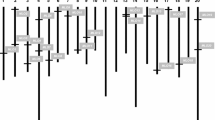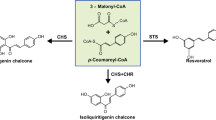Abstract
The Mlo gene was discovered in barley because the mutant ‘mlo’ allele conferred broad-spectrum, non-race-specific resistance to powdery mildew caused by Blumeria graminis f. sp. hordei. The Mlo genes also play important roles in growth and development of plants, and in responses to biotic and abiotic stresses. The Mlo gene family has been characterized in several crop species, but only a single legume species, soybean (Glycine max L.), has been investigated so far. The present report describes in silico identification of 18 CcMlo and 20 PvMlo genes in the important legume crops Cajanus cajan (L.) Millsp. and Phaseolus vulgaris L., respectively. In silico analysis of gene organization, protein properties and conserved domains revealed that the C. cajan and P. vulgaris Mlo gene paralogs are more divergent from each other than from their orthologous pairs. The comparative phylogenetic analysis classified CcMlo and PvMlo genes into three major clades. A comparative analysis of CcMlo and PvMlo proteins with the G. max Mlo proteins indicated close association of one CcMlo, one PvMlo with two GmMlo genes, indicating that there was no further expansion of the Mlo gene family after the separation of these species. Thus, most of the diploid species of eudicots might be expected to contain 15–20 Mlo genes. The genes CcMlo12 and 14, and PvMlo11 and 12 are predicted to participate in powdery mildew resistance. If this prediction were verified, these genes could be targeted by TILLING or CRISPR to isolate powdery mildew resistant mutants.



Similar content being viewed by others
References
Acevedo-Garcia J, Kusch S, Panstruga R (2014) Magical mystery tour: MLO proteins in plant immunity and beyond. New Phytol. doi:10.1111/nph.12889.2014
Altschul SF, Gish W, Miller W, Myers EW, Lipman DJ (1990) Basic local alignment search tool. J Mol Biol 215:403–410
Appiano M, Pavan S, Catalano D et al (2015) Identification of candidate MLO powdery mildew susceptibility genes in cultivated Solanaceae and functional characterization of tobacco NtMLO1. Transgenic Response. doi:10.1007/s11248-015-9878-4
Atzema JL (1998) Durability of mlo resistance in barley against powdery mildew caused by Erysiphe graminis f. sp. hordei. Dissertation, Swiss Federal Institute of Technology, Zurich
Bai Y, Pavan S, Zheng Z, Zappel NF, Reinstädler A, Lotti C, De Giovanni C, Ricciardi L, Lindhout P, Visser R, Theres K, Panstruga R (2008) Naturally occurring broad-spectrum powdery mildew resistance in a Central American tomato accession is caused by loss of mlo function. Mol Plant Microbe Interact 21:30–39
Bailey TL, Williams N, Misleh C, Li WW (2006) MEME: discovering and analyzing DNA and protein sequence motifs. Nucleic Acids Res 34:W369–W373
Burge C, Karlin S (1997) Prediction of complete gene structures in human genomic DNA. J Mol Biol 268:78–94
Büschges R, Hollricher K, Panstruga R, Simons G, Wolter M, Frijters A et al (1997) The barley MLO gene: a novel control element of plant pathogen resistance. Cell 88:695–705
Chen Z, Hartmann HA, Wu MJ, Friedman EJ, Chen JG, Pulley M, Schulze-Lefert P, Panstruga R, Jones AM (2006) Expression analysis of the AtMLO gene family encoding plant-specific seven-transmembrane domain proteins. Plant Mol Biol 60:583–597
Chen Z, Noir S, Kwaaitaal M, Hartmann HA, Wu MJ, Mudgil Y, Sukumar P, Muday G, Panstruga R, Jones AM (2009) Two seven-transmembrane domain MILDEW RESISTANCE LOCUS O proteins cofunction in Arabidopsis root thigmomorphogenesis. Plant Cell 21:1972–1991
Cheng H, Kun W, Liu D, Su Y, He Q (2012) Molecular cloning and expression analysis of CmMlo1 in melon. Mol Biol Rep 39:1903–1907
Deshmukh R, Singh VK, Singh BD (2014) Comparative phylogenetic analysis of genome-wide Mlo gene family members from Glycine max and Arabidopsis thaliana. Mol Genet Genomics 289:345–359
Devoto A, Piffanelli P, Nilsson I, Wallin E, Panstruga R, von Heijne G, Schulze-Lefert P (1999) Topology, subcellular localization, and sequence diversity of the Mlo family in plants. J Biol Chem 274:34993–35004
Devoto A, Hartmann HA, Piffanelli P, Elliott C, Simmons C, Taramino G, Goh CS, Cohen FE, Emerson BC, Schulze-Lefert P, Panstruga R (2003) Molecular phylogeny and evolution of the plant-specific seven-transmembrane MLO family. J Mol Evol 56:77–88
Elliott C, Müller J, Miklis M, Bhat RA, Schulze-Lefert P, Panstruga R (2005) Conserved extracellular cysteine residues and cytoplasmic loop–loop interplay are required for functionality of the heptahelical MLO protein. Biochem J 385:243–254
Feechan A, Jermakow AM, Dry IB (2009) Grapevine MLO candidates required for powdery mildew pathogenicity? Plant Signal Behav 4:522–523
Franceschini A, Szklarczyk D, Frankild S et al (2013) STRING v9.1: protein–protein interaction networks, with increased coverage and integration. Nucleic Acids Res 41:808–815
Guo AY, Zhu QH, Chen X, Luo JC (2007) GSDS: a gene structure display server. Yi Chuan 29:1023–1026
Hall TA (1999) BioEdit: a user-friendly biological sequence alignment editor and analysis program for Windows 95/98/NT. Nucleic Acids Symp Ser 41:95–98
Humphry M, Reinstädler A, Ivanov S, Bisseling T, Panstruga R (2011) Durable broad-spectrum powdery mildew resistance in pea er1 plants is conferred by natural loss-of-function mutations in PsMLO1. Mol Plant Pathol 12:866–878
Jørgensen IH (1992) Discovery, characterization and exploitation of Mlo powdery mildew resistance in barley. Euphytica 63:141–152
Kaufmann H, Qiu X, Wehmeyer J, Debener T (2012) Isolation, molecular characterization, and mapping of four rose MLO orthologs. Front Plant Sci. doi:10.3389/fpls.2012.00244
Kim DS, Hwang BK (2012) The pepper MLO gene, CaMLO2, is involved in the susceptibility cell-death response and bacterial and oomycete proliferation. Plant J 72:843–855
Kim MC, Lee SH, Kim JK, Chun HJ, Choi MS et al (2002a) MLO, a modulator of plant defense and cell death, is a novel calmodulin-binding protein. J Biol Chem 277:19304–19314
Kim MC, Panstruga R, Elliott C, Müller J, Devoto A, Yoon HW, Park HC, Cho MJ, Schulze-Lefert P (2002b) Calmodulin interacts with MLO protein to regulate defence against mildew in barley. Nature 416:447–450
Konishi S, Sasakuma T, Sasanuma T (2010) Identification of novel Mlo family members in wheat and their genetic characterization. Genes Genet Syst 85:167–175
Kudapa H, Bharti AK, Cannon SB et al (2012) A comprehensive transcriptome assembly of pigeonpea (Cajanus cajan L.) using Sanger and second-generation sequencing platforms. Mol Plant 5:1020–1028
Kumar J, Hückelhoven R, Beckhove U, Nagarajan S, Kogel KH (2001) A compromised Mlo pathway affects the response of barley to the necrotrophic fungus bipolaris sorokiniana (Teleomorph: Cochliobolus sativus) and its toxins. Phytopathology 91:127–133
Lescot M, Déhais P, Thijs G, Marchal K, Moreau Y, Van de Peer Y, Rouzé P, Rombauts S (2002) PlantCARE, a database of plant cis-acting regulatory elements and a portal to tools for in silico analysis of promoter sequences. Nucleic Acid Res 30:325–327
Li YH, Zhou G, Ma J et al (2014) De novo assembly of soybean wild relatives for pan-genome analysis of diversity and agronomic traits. Nat Biotechnol 32:1045–1052
Lim CW, Lee SC (2014) Functional roles of the pepper MLO protein gene, CaMLO2, in abscisic acid signaling and drought sensitivity. Plant Mol Biol 85:1–10
Liu Q, Zhu H (2008) Molecular evolution of the Mlo gene family in Oryza sativa and their functional divergence. Gene 409:1–10
Lorek J, Griebel T, Jones A, Kuhn H, Panstruga R (2013) The role of Arabidopsis heterotrimeric G-protein subunits in MLO2 function and MAMP-triggered immunity. Mol Plant Microbe Interact. doi: 10.1094/MPMI-03-13-0077-R
McClean PE, Mamidi S, McConnell M, Chikara S, Lee R (2010) Synteny mapping between common bean and soybean reveals extensive blocks of shared loci. BMC Genomics 11:184–193
O’Connell RJ, Panstruga R (2006) Tête à tête inside a plant cell: establishing compatibility between plants and biotrophic fungi and oomycetes. New Phytol 171:699–718
Panstruga R (2005a) Serpentine plant MLO proteins as entry portals for powdery mildew fungi. Biochem Soc Trans 33:389–392
Panstruga R (2005b) Discovery of novel conserved peptide domains by ortholog comparison within plant multi-protein families. Plant Mol Biol 59:485–500
Pereira-Leal JB, Levy ED, Kamp C, Teichmann SA (2007) Evolution of protein complexes by duplication of homomeric interactions. Genome Biol 8:R51.1–R51.12
Pessina S, Pavan S, Catalano D, Gallotta A, Visser RG, Bai Y, Malnoy M, Schouten HJ (2014) Characterization of the MLO gene family in Rosaceae and gene expression analysis in Malus domestica. BMC Genomics 15:618–629
Piffanelli P, Zhou F, Casais C, Orme J, Jarosch B, Schaffrath U, Collins NC, Panstruga R, Schulze-Lefert P (2002) The barley MLO modulator of defence and cell death is responsive to biotic and abiotic stress stimuli. Plant Physiol 129:1076–1085
Punta M, Coggill PC, Eberhardt RY, Mistry J, Tate J (2012) The Pfam protein families database. Nucleic Acid Res. doi:10.1093/nar/gkr1065
Quevillon E, Silventoinen V, Pillai S, Harte N, Mulder N, Apweiler R, Lopez R (2005) InterProScan: protein domains identifier. Nucleic Acid Res 33:116–120
Sanchez-Perez G, Mira A, Nyiro G, Pasić L, Rodriguez-Valera F (2008) Adapting to environmental changes using specialized paralogs. Trends Genet 24:154–158
Schmutz J, Cannon SB, Schlueter J et al (2010) Genome sequence of the palaeopolyploid soybean. Nature 463:178–183
Schmutz J, McClean PE, Mamidi S, Wu GA, Cannon SB (2014) A reference genome for common bean and genome-wide analysis of dual domestications. Nat Genet 46:707–713
Shen Q, Zhao J, Du C, Xiang Y, Cao J, Qin X (2012) Genome-scale identification of MLO domain-containing genes in soybean (Glycine max L. Merr.). Genes Genet Syst 87:89–98
Sievers F, Wilm A, Dineen D et al (2011) Fast, scalable generation of high-quality protein multiple sequence alignments using Clustal Omega. Mol Syst Biol 7:539–544
Singh VK, Singh AK, Chand R, Singh BD (2012a) Genome wide analysis of disease resistance MLO gene family in sorghum (Sorghum bicolor L. Moench). J Plant Genomics 2:18–27
Singh NK, Gupta DK, Jayaswal PK, Mahato AK et al (2012b) The first draft of the pigeonpea genome sequence. J Plant Biochem Biotechnol 21:98–112
Swarbreck D, Wilks C, Lamesch P, Berardini TZ et al (2008) The Arabidopsis information resource (TAIR): gene structure and function annotation. Nucleic Acids Res 36:D1009–D1014
Tamura K, Peterson D, Peterson N, Stecher G, Nei M, Kumar S (2011) MEGA5: molecular evolutionary genetics analysis using maximum likelihood, evolutionary distance, and maximum parsimony methods. Mol Biol Evol 28:2731–2739
Thompson JD, Higgins DG, Gibson TJ (1994) ClustalW: improving the sensitivity of progressive multiple sequence alignment through sequence weighting, position-specific gap penalties and weight matrix choice. Nucleic Acids Res 22:4673–4680
Tusnády GE, Simon I (2001) The HMMTOP transmembrane topology prediction server. Bioinformatics 17:849–850
Varshney RK, Chen W, Li Y, Bharti AK et al (2012) Draft genome sequence of pigeonpea (Cajanus cajan), an orphan legume crop of resource-poor farmers. Nat Biotechnol 30:83–89
Vetter IR, Baase WA, Heinz DW, Xiong JP, Snow S, Matthews BW (1996) Protein structural plasticity exemplified by insertion and deletion mutants in T4 lysozyme. Protein Sci 5:2399–2415
Wang Y, Cheng X, Shan Q, Zhang Y, Liu J, Gao C, Qiu JL (2014) Simultaneous editing of three homoeoalleles in hexaploid bread wheat confers heritable resistance to powdery mildew. Nat Biotechnol 32:947–951
Yu CS, Chen YC, Lu CH, Hwang JK (2006) Prediction of protein subcellular localization. Proteins 64:643–651
Zhou SJ, Jing Z, Shi JL (2013) Genome-wide identification, characterization, and expression analysis of the MLO gene family in Cucumis sativus. Genet Mol Res 12:6565–6578
Zielinski RE (1998) Calmodulin and calmodulin-binding proteins in plants. Annu Rev Plant Physiol Plant Mol Biol 49:697–725
Acknowledgments
This research was financially supported by the University Grant Commission, New Delhi (Junior Research Fellowship Grant to RD). The SUB-DIC Centre at School of Biotechnology, Banaras Hindu University, funded by the Department of Biotechnology, New Delhi provided the authors access to the different software used in this study.
Author information
Authors and Affiliations
Corresponding author
Ethics declarations
Conflict of interest
The authors declare that they have no conflict of interest.
Ethical approval
This article does not contain any studies with human participants or animals performed by any of the authors.
Electronic supplementary material
Below is the link to the electronic supplementary material.
Rights and permissions
About this article
Cite this article
Deshmukh, R., Singh, V.K. & Singh, B.D. Comparative analysis of genome-wide Mlo gene family in Cajanus cajan and Phaseolus vulgaris . Genetica 144, 229–241 (2016). https://doi.org/10.1007/s10709-016-9893-2
Received:
Accepted:
Published:
Issue Date:
DOI: https://doi.org/10.1007/s10709-016-9893-2




